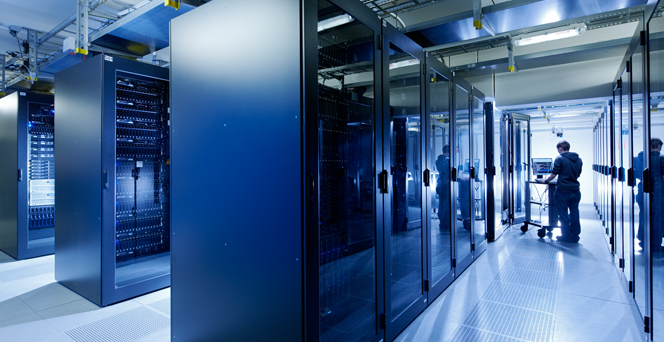URL: https://www.desy.de/e141261/e158573/e158743/index_eng.html
Breadcrumb Navigation

IDAF
Computing infrastructure IDAF
In all research areas at DESY, experiments produce rapidly growing amounts of data that are analysed by thousands of scientists around the world – an enormous challenge in terms of data storage and computing power. In the Interdisciplinary Data and Analysis Facility (IDAF), DESY provides extensive, state-of-the-art storage and computing capacities for the national and international scientific community.
The LHC accelerator near Geneva, the current flagship of particle physics and the world’s most powerful accelerator, generates data amounting to over 300 petabytes (300 million gigabytes) each year, enough to fill more than ten million Blu-ray discs a year. With the upgrade to increase the collision rate – the high-luminosity LHC – this flood of data will increase even further, necessitating a significant improvement in the software and algorithms used to handle it. At the same time, the amount of data produced in photon science and astroparticle physics is also growing rapidly, as is the demand for computing power in research on future accelerators and accelerator technologies. For example, DESY currently stores over 100 petabytes of data from the X-ray light sources European XFEL and PETRA III. The IDAF computing infrastructure at DESY combines three different computer complexes that are optimally tailored to meet these challenges.
DESY Grid
To manage the flood of data produced in particle physics, information scientists use the concept of grid computing, in which computers distributed around the globe are connected in such a way that they can be used as a very large supercomputer. The data from the experiments are no longer stored and processed in one place, but distributed to a series of computing centres, from where they are transferred to other facilities and ultimately to the participating scientists. DESY is contributing large computing and storage systems to this worldwide computer network, along with centralised infrastructures for the experiments, support and consulting.
Across its Hamburg and Zeuthen sites, DESY operates a so-called Tier-2 centre for the LHC experiments ATLAS, CMS and LHCb. It is one of the largest centres in the LHC grid and is used by research groups all over the world. The grid infrastructure at DESY also serves as a raw-data centre for the Belle II experiment in Japan as well as other experiments in particle physics and astroparticle physics.
NAF – National Analysis Facility
The computing complex NAF at DESY was set up in the context of the Helmholtz Alliance “Physics at the Terascale”, a Germany-wide network of particle physicists working on the LHC and on plans for future particle accelerators. The NAF is closely linked to the grid infrastructure at DESY and provides computer resources for physics analysis to all Alliance members and the globally distributed Belle II collaboration. Other, smaller particle physics experiments at DESY, such as the axion experiments ALPS II, BabyIAXO and MADMAX, also use the NAF. Indeed, it is not always necessary to run the calculations for the data analysis on the worldwide grid. If the scientists want to try out new ideas for algorithms and computer processes, for example, they can usually accomplish this faster and much more easily on a smaller computer architecture. This is the purpose of the NAF at DESY.
The NAF offers particle physicists simplified, fast and interactive access to experiment data and additional resources to analyse these data. If required, the NAF team offers assistance in the form of support and training, especially for young scientists.
Maxwell HPC Cluster
DESY also operates the Maxwell HPC Cluster, a high-performance computing system for applications that cannot be served by the grid or the NAF. Thanks to the ultrafast networking of the computers with each other and with the storage systems, the cluster can be used in particular for data acquisition and real-time data analysis of photon science experiments at the X-ray light sources PETRA III, FLASH and European XFEL, where the data sets are partly recorded at extremely fast repetition rates. The cluster also enables machine learning applications on specialised graphics card systems and the execution of massively parallel computing tasks, e.g. for research into plasma acceleration or calculations of molecular dynamics. DESY provides a wide range of application software and services and offers support and training.


